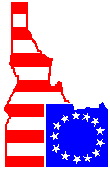From the May 2005 Idaho Observer:
Memo indicates Bush, et al, knew Saddam had no WMD
Congress quickly sends letter to president demanding explanation; no comment thus far from White House
by Greg Szymanski
Congress is "hot on the heels" of President Bush after an explosive memo released to the London press this week clearly shows he "doctored" intelligence reports about WMD in order to justify attacking Iraq.
Eighty-eight members of Congress have quickly authored a letter to Bush, demanding answers regarding the memo clearly showing the administration’s "deceptive posture" and "outright determination" to topple Saddam Hussein as if credible intelligence reports of WMD existed.
The Bush administration has not officially commented on the congressional letter, dated May 5, 2005, and sent directly to the White House. The potentially damaging memo was leaked to the London, revealing an internal memo sent on July 23, 2002, by Matthew Rycroft, a former defense policy aide. Rycroft addressed his concerns about America’s deceptive "rush to war" to England’s heads of state, including the Prime Minister, Defense secretary, Foreign Secretary and Attorney General.
Since the U.S. invaded Iraq based on an imminent threat of WMD, the Bush administration has stood firm on its decision to topple Hussein, claiming it should not be now blamed for faulty intelligence reports. To date no weapons of mass destruction have ever been uncovered in Iraq and serious questions have been raised about America’s "rush to judgment" in attacking Iraq.
The memo, which has been verified as "Secret and Personal—For UK Eyes Only," clearly shows the Bush administration lied to the American people about its basis for going to war in Iraq. To date over 1,700 American troops have been killed in the fighting and estimates of over 100,000 innocent Iraqi civilians have also perished.
The letter sent to Bush was authored by Rep. John Conyers (D-MI), who is demanding accountability and is expressing deep concern the mainstream American media has not picked up on the British reports.
"Unfortunately, the mainstream media in the United States was too busy with wall-to-wall coverage of a "runaway bride" to cover a bombshell report out of the British newspapers," Conyers writes in his letter. "The London Times reports that the British government and the United States government had secretly agreed to attack Iraq in 2002, before authorization was sought for such an attack in Congress, and had discussed creating pre-textual justifications for doing so Conyers continued: "The Times reports, based on a newly discovered document, that in 2002 British Prime Minister Tony Blair chaired a meeting in which he expressed his support for "regime change" through the use of force in Iraq and was warned by the nation’s top lawyer that such an action would be illegal. Blair also discussed the need for America to ‘create’ conditions to justify the war."
The London press claims to have verified the authenticity of the explosive memo before publication, also blaming its own government for following America to war even though it had solid evidence no weapons of mass destruction existed in Iraq.
Just prior to U.S. invasion, Rycroft, who was privy to highly classified U.S. intelligence reports, clearly reveals a deceptive strategy on the part of the Bush administration to topple Hussein when he wrote:
"As reported in recent talks in Washington, there was a perceptible shift in attitude. Military action was now seen as inevitable. Bush wanted to remove Sadaam, through military action, justified by the conjunction of terrorism and WMD.
"But the intelligence and facts were being fixed around the policy. The NSC [National Security Commission] had no patience with the UN route, and no enthusiasm for publishing material on the Iraqi regime’s record. There was little discussion in Washington of the aftermath after military action."
Regarding the memo, the Bush administration refused comment saying it was unaware of the specific allegations. Critics claim this memo clearly rebukes the justification of war, resulting in a clear violation of international law.
The memo went on to delineate two possible U.S. war strategies, Iraq’s most likely response and Bush’s personal awareness of the whole plan.
According to the memo, "U.S. military planners are to brief CENTCOM on 1-2 August, Rumsfeld on 3 August and Bush on 4 August (2002). The two broad US (war) options were:
" (a) Generated Start. A slow build-up of 250,000 US troops, a short (72 hour) air campaign, then a move up to Baghdad from the south. Lead time of 90 days (30 days preparation plus 60 days deployment to Kuwait).
" (b) Running Start. Use forces already in theatre (3 x 6,000), continuous air campaign. Total lead time of 60 days with the air campaign beginning even earlier. A hazardous option."
Critics of the Bush administration war strategy claim this shows clearly that Bush "lied to the America people and should be held accountable," giving a full explanation about the contents of the Rycroft memo.
Greg Szymanski is the co-editor of The Report of the Citizens Commission on 9/11 and the editor at The Arctic Beacon—an electronic digest of political, social and paranormal stories at www.arcticbeacon.citymaker.com.

Home - Current Edition
Advertising Rate Sheet
About the Idaho Observer
Some recent articles
Some older articles
Why we're here
Subscribe
Our Writers
Corrections and Clarifications
Hari Heath
Vaccination Liberation - vaclib.org